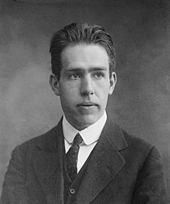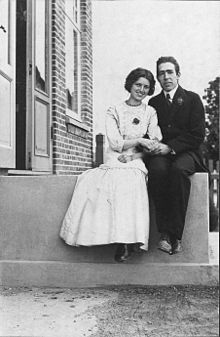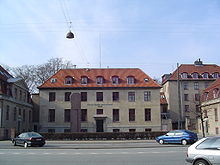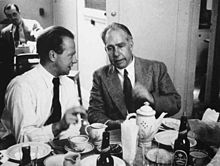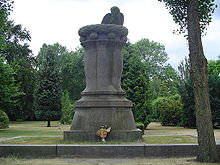
Niels Bohr
Background Information
SOS Children made this Wikipedia selection alongside other schools resources. A quick link for child sponsorship is http://www.sponsor-a-child.org.uk/
| Niels Bohr | |
|---|---|
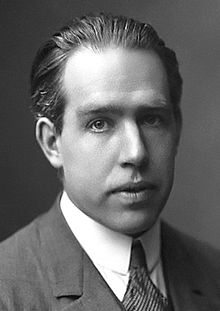 |
|
| Born | Niels Henrik David Bohr 7 October 1885 Copenhagen, Denmark |
| Died | 18 November 1962 (aged 77) Copenhagen, Denmark |
| Nationality | Danish |
| Fields | Physics |
| Institutions |
|
| Alma mater | University of Copenhagen |
| Doctoral advisor | Christian Christiansen |
| Other academic advisors | J. J. Thomson Ernest Rutherford |
| Doctoral students | Hendrik Anthony Kramers |
| Known for |
|
| Influences |
|
| Influenced |
|
| Notable awards |
|
| Spouse | Margrethe Nørlund |
| Signature |
|
Niels Henrik David Bohr (Danish: [ˈnels ˈboɐ̯ˀ]; 7 October 1885 – 18 November 1962) was a Danish physicist, philosopher and footballer, who made foundational contributions to understanding atomic structure and quantum mechanics, for which he received the Nobel Prize in Physics in 1922. Bohr was a passionate footballer who played goalkeeper for the Copenhagen-based Akademisk Boldklub.
Bohr developed the Bohr model of the atom with the atomic nucleus at the centre and electrons in orbit around it, which he compared to the planets orbiting the Sun. He helped develop quantum mechanics, in which electrons move from one energy level to another in discrete steps, instead of continuously. He founded the Institute of Theoretical Physics at the University of Copenhagen, now known as the Niels Bohr Institute, which opened in 1920. Bohr mentored and collaborated with physicists including Hans Kramers, Oskar Klein, George de Hevesy and Werner Heisenberg. He predicted the existence of a new zirconium-like element, which was named hafnium, after Copenhagen, when it was discovered. Later, the element Bohrium was named after him. He conceived the principle of complementarity: that items could be separately analysed as having contradictory properties, like behaving as a wave or a stream of particles. The notion of complementarity dominated his thinking on both science and philosophy.
During the 1930s, Bohr gave refugees from Nazism temporary jobs at the Institute, provided them with financial support, arranged for them to be awarded fellowships from the Rockefeller Foundation, and ultimately found them places at various institutions around the world. After Denmark was occupied by the Germans, he had a dramatic meeting in Copenhagen with Heisenberg, who had become the head of the German nuclear energy project. In 1943, fearing arrest, Bohr fled to Sweden, where he persuaded King Gustav V of Sweden to make public Sweden's willingness to provide asylum. He was then flown to Britain, where he joined the British Tube Alloys nuclear weapons project, and was part of the British team of physicists who worked on the Manhattan Project. After the war, Bohr called for international cooperation on nuclear energy. He was involved with the establishment of CERN, and became the first chairman of the Nordic Institute for Theoretical Physics in 1957. He was also involved with the founding of the Risø DTU National Laboratory for Sustainable Energy.
Early years
Niels Bohr was born in Copenhagen, Denmark, on 7 October 1885, the second of three children of Christian Bohr, a professor of physiology at the University of Copenhagen, and Ellen Adler Bohr, who came from a wealthy Danish Jewish family prominent in banking and parliamentary circles. He had an older sister, Jenny, and a younger brother Harald. Jenny became a teacher, while Harald became a mathematician and Olympic footballer who played on the Danish national team at the 1908 Summer Olympics in London. Niels was a passionate footballer as well, and the two brothers played a number of matches for the Copenhagen-based Akademisk Boldklub, with Niels as goalkeeper.
Bohr was educated at Gammelholm Latin School, which he started when he was seven. In 1903, Bohr enrolled as an undergraduate at Copenhagen University. His major was physics, which he studied under Professor Christian Christiansen, the university's only professor of physics at that time. He also studied astronomy and mathematics under Professor Thorvald Thiele, and philosophy under Professor Harald Høffding, a friend of his father's.
In 1905, there was a gold medal competition, sponsored by the Royal Danish Academy of Sciences and Letters, to investigate a method for measuring the surface tension of liquids that had been proposed by Lord Rayleigh in 1879. Bohr conducted a series of experiments, using his father's laboratory in the university because the university had no physics laboratory. To accomplish them, he had to become his own glass blower, creating test tubes with the required elliptical cross-sections. He went beyond the original task, incorporating improvements into both the theory and the method. His essay, which he submitted at the last minute, won the prize. He subsequently submitted an improved version of the paper to the Royal Society in London for publication in the Philosophical Transactions of the Royal Society.
Harald became the first of the two Bohr brothers to earn a master's degree, for mathematics in April 1909. Although he was older, Bohr took another nine months to earn his. He had to submit a thesis on a subject assigned by his supervisor. In Bohr's case, his supervisor was Christiansen, and the topic was on the electron theory of metals. Bohr subsequently elaborated his master's thesis into his much larger Doctor of Philosophy (PhD) thesis. He surveyed the literature on the subject, and settled on a model postulated by Paul Drude and elaborated by Hendrik Lorentz in which the electrons in a metal are considered to behave like a gas. Bohr extended Lorentz's model but was still unable to account for phenomena like the Hall effect, and concluded that electron theory could not fully explain the magnetic properties of metals. The thesis was accepted in April 1911, and Bohr conducted his formal defence on 13 May. Once again, Bohr was behind his younger brother Harald, who had received his PhD the previous year.
Earlier in 1910, Bohr met Margrethe Nørlund, the sister of the mathematician Niels Erik Nørlund. Bohr resigned his membership in the Lutheran Church on 16 April 1912, and he and Margrethe were married in a civil ceremony at the town hall in Slagelse on 1 August. Years later, his brother Harald would similarly leave the church before getting married. Niels and Margrethe had six sons. The oldest, Christian, died in a boating accident in 1934, and another, Harald, died from childhood meningitis. The other four went on to lead successful lives. Aage Bohr became a successful physicist and in 1975, like his father, was awarded the Nobel Prize in physics. His other sons were Hans Henrik, a physician; Erik, a chemical engineer; and Ernest, a lawyer, who, like Niel's brother Harald, became an Olympic athlete, and played field hockey for Denmark at the 1948 Summer Olympics in London.
Physics
Bohr model
In 1911, Bohr travelled to England, where he met with J. J. Thomson, of Trinity College, Cambridge and Cavendish Laboratory. He attended lectures on electromagnetism given by James Jeans and Joseph Larmor, and did some research on cathode rays, but failed to impress Thomson. However, he had more success with Ernest Rutherford from Victoria University of Manchester, whose 1911 Rutherford model of the atom had recently challenged Thomson's plum pudding model, and Bohr received an invitation to conduct post-doctoral work at Manchester. As a post-doctoral student there, Bohr met George de Hevesy, and Charles Galton Darwin (whom Bohr referred to as "the grandson of the real Darwin"), and was intrigued by a paper of Darwin's on electrons.
Bohr returned to Denmark in July 1912 for his wedding, and travelled around England and Scotland on his honeymoon. On his return, he became a privatdocent at the University of Copenhagen, and gave lectures on thermodynamics. Martin Knudsen put Bohr's name forward for a docent, which was approved in July 1913, and Bohr began teaching medical students. His three famous papers, which became known as "the Trilogy", were published in Philosophical Magazine in July, September and November of that year. He adapted Rutherford's nuclear structure to Max Planck's quantum theory and so created his Bohr model of the atom. Here he introduced the theory of electrons travelling in orbits around the atom's nucleus, with the chemical properties of each element being largely determined by the number of electrons in the outer orbits of its atoms. He also introduced the idea that an electron could drop from a higher-energy orbit to a lower one, in the process emitting a quantum of discrete energy. This became a basis for what is now called the old quantum theory.
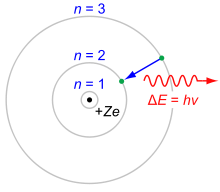
In 1885, Johann Balmer had come up with his Balmer series for describing the visible spectral lines of a hydrogen atoms:
where λ is the wavelength of the absorbed/emitted light and RH is known as the Rydberg constant. Balmer's formula worked was corroborated by the discovery of additional spectral lines, but for thirty years, no one could explain why it worked. In the first paper of the Bohr was able to derive it from his model:
where me is the electron's mass, e is its charge, h is Planck's constant and Z is the atom's atomic number (which is 1 for Hydrogen). One problem was the Pickering series, lines which did not fit Balmer's formula. When challenged on this by Alfred Fowler, Bohr replied that they were caused by ionised helium – helium atoms with only one electron. The model was found to work for them too. Reaction to the Trilogy was mixed. Many older physicists like Thomson and Rayleigh did not like it, although Emil Warburg thought highly of it, but the younger generation, including Ernest Rutherford, David Hilbert, Albert Einstein, Max Born and Arnold Sommerfeld saw the Trilogy as a breakthrough.
Bohr did not enjoy teaching medical students, and decided to return to Manchester, where Rutherford had offered him a job as a reader in place of Darwin, whose tenure had expired. Bohr accepted. He took a leave of absence from the University of Copenhagen, but started by taking a holiday in Tyrol with his brother Harald and aunt Hanna Adler, visiting the University of Göttingen and the Ludwig Maximilian University of Munich, where he met Sommerfeld, and conducted seminars on the Trilogy. The First World War broke out while they were in Tyrol, greatly complicating this trip back to Denmark, and Bohr's subsequent voyage with Margrethe to England, where he arrived in October 1914. They stayed until July 1916, by which time he had been appointed to the Chair of Theoretical Physics at the University of Copenhagen, a position created especially for him. His docentship was abolished at the same time, so he still had to teach physics to medical students. New professors were formally introduced to the king, Christian X, who expressed his delight at meeting such a famous football player.
Institute of Physics
In April 1917, Bohr began a campaign to establish an Institute of Theoretical Physics. He gained the support of the Danish government and the Carlsberg Foundation, and sizeable contributions were also made by industry and private donors, many of them Jewish. Legislation establishing the Institute was passed in November 1918. Now known as the Niels Bohr Institute, it opened its doors on 3 March 1921, with Bohr as its director and his family moving into an apartment on the first floor. Bohr's institute served as a focal point for researchers into Quantum Mechanics and related subjects in the 1920s and 1930s, when most of the world's best known theoretical physicists spent some time in his company. Early arrivals included Hans Kramers from the Netherlands, Oskar Klein from Sweden, George de Hevesy from Hungary, Wojciech Rubinowicz from Poland and Svein Rosseland from Norway. Bohr became widely appreciated as their congenial host and eminent colleague. Klein and Rosseland produced the Institute's first paper even before it opened.
While the Bohr model worked well for hydrogen, it could not explain more complex elements, and by 1919, Bohr was moving away from the idea that electrons orbited the nucleus, and he developed heuristics to describe them. The rare earth elements posed a particular classification problem for chemists, on account of their being so chemically similar. An important development came in 1924 with Wolfgang Pauli's discovery of the Pauli exclusion principle, which put Bohr's models on a firm theoretical footing. Bohr was able to then declare that the as-yet-undiscovered element 72 was not a rare earth element, but an element with chemical properties like zirconium. He was immediately challenged by the French chemist, Georges Urbain, who claimed to have discovered a rare earth element 72, which he called "celtium". At the Institute in Copenhagen, Dirk Coster and Georg de Hevesy took up the challenge of proving Bohr right and Urbain wrong. They went through samples from Copenhagen's Museum of Mineralogy looking for a zirconium-like element. They found it, and named it hafnium, Hafnia being the Latin name for Copenhagen. In 1922, Bohr was awarded the Nobel Prize in physics "for his services in the investigation of the structure of atoms and of the radiation emanating from them". The award thus recognised both the Trilogy and his early leading work in the emerging field of quantum mechanics. For his Nobel lecture, Bohr treated his audience to a comprehensive survey of what was then known about the structure of the atom, including his correspondence principle.
The discovery of Compton scattering by Arthur Holly Compton in 1923 convinced most physicists that light was composed of photons, and that energy and momentum were conserved in collisions between electrons and photons. In 1924, Bohr, Kramers and John C. Slater, an American physicist working at the Institute in Copenhagen, proposed the Bohr-Kramers-Slater theory (BKS) in 1924. It was perhaps more a program than a full physical theory, as the ideas that were developed were not worked out in a quantitative way. BKS theory was perhaps the final attempt at understanding the interaction of matter and electromagnetic radiation on the basis of the so-called Old quantum theory, in which quantum phenomena are treated by imposing quantum restrictions on a classical wave description of the electromagnetic field. One aspect, the idea of modelling atomic behaviour under incident electromagnetic radiation using "virtual oscillators" at the absorption and emission frequencies, rather than the (different) apparent frequencies of the Bohr orbits, significantly led Max Born, Werner Heisenberg and Kramers to explore mathematics that strongly inspired the subsequent development of matrix mechanics, the first form of modern quantum mechanics. The provocativeness of the theory also generated great discussion and renewed attention to the difficulties in the foundations of the old quantum theory. However, the most provocative element of the theory, that momentum and energy would not necessarily be conserved in each interaction but only overall, statistically, was soon shown to be in conflict with experiments conducted by Walter Bothe and Hans Geiger. In the light of these results, Bohr informed Darwin, "there is nothing else to do than to give our revolutionary efforts as honourable a funeral as possible."
Quantum mechanics
A turning point was the introduction of spin by George Uhlenbeck, and Samuel Goudsmit in November 1925. The next month, Bohr headed down to Leiden to attend celebrations of the 50th anniversary of Hendrick Lorentz receiving his doctorate. When his train stopped in Hamburg, he was met by Wolfgang Pauli and Otto Stern, who asked for his opinion of the spin theory. Bohr pointed out that he had concerns about the interaction between the electron and the magnetic field. On arrival in Leiden, however, he was met by Paul Ehrenfest and Albert Einstein, who informed him that Einstein had resolved this problem using relativity. Bohr then had Uhlenbeck and Goudsmit incorporate this into their paper. Thus, when he met Werner Heisenberg and Pascual Jordan in Göttingen on the way back, he had become, in his own words, "a prophet of the electron magnet gospel".
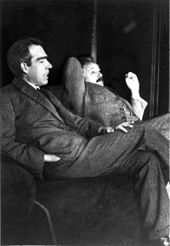
Heisenberg first came to Copenhagen in 1924. He returned to Göttingen in June 1925, but when Kramers left the Institute in 1926 to take up a chair as professor of theoretical physics at the Utrecht University, Bohr arranged for Heisenberg to take Kramers's place as a lektor at the University of Copenhagen. Heisenberg worked as an assistant to Bohr and university lecturer in Copenhagen from 1926 to 1927, and it was in Copenhagen, in 1925, that Heisenberg developed the mathematical foundations of quantum mechanics. When he showed his results to Max Born in Göttingen, Born realised that they could best be expressed using matrices. This work also attracted the attention of the British physicist Paul Dirac, who came to Copenhagen for six months in September 1926. Another visitor in 1926 was the Austrian physicist Erwin Schrödinger, whose attempts at explaining quantum physics in classical terms using wave mechanics impressed Bohr as contributing "so much to mathematical clarity and simplicity that it represents a gigantic advance over all previous forms of quantum mechanics".
Bohr was now convinced that light behaved like both waves and particles, and in 1927, experiments confirmed the de Broglie hypothesis that matter like electrons also behaved like waves. Bohr conceived the principle of complementarity: that items could be separately analysed as having several contradictory properties, such as a wave or a stream of particles depending on the experimental framework – two apparently mutually exclusive properties – on the basis of this principle. "Shortly before his death [Bohr] complained that no professional philosopher had ever understood his doctrine of complementarity."
It was in Copenhagen in 1927 that Heisenberg developed his uncertainty principle. Bohr embraced the new principle, and in a paper he presented at a conference at Como in September 1927, he demonstrated that the uncertainty principle could be derived from classical arguments, and without quantum terminology or matrices. Einstein much preferred the determinism of classical physics over the probabilistic new quantum physics to which Einstein himself had contributed. Philosophical issues that arose from the novel aspects of quantum mechanics became widely celebrated subjects of discussion. Einstein and Bohr had good-natured arguments over such issues throughout their lives.
In 1914, Carl Jacobsen, the founder of the Carlsberg breweries, had left his mansion, Aeresbolig, to be used for life by the Dane who had made the most prominent contribution to science, literature or the arts. Harald Høffding had become the first occupant. He died in July 1931, and the Royal Danish Academy of Sciences and Letters decided that Bohr should be the next occupant of the Aeresbolig. Bohr and his family moved to Aeresbolig in the summer of 1932. He was elected president of the Academy on 17 March 1939.
By 1929, the phenomenon of beta decay once again had Bohr suggesting that the law of conservation of energy be abandoned, but Enrico Fermi's hypothetical neutrino and the subsequent 1932 discovery of the neutron provided another explanation. This prompted Bohr to create a new theory of the compound nucleus in 1936, which explained how neutrons could be captured by the nucleus. In this model, the nucleus could be deformed like a drop of liquid. He worked on this with a new collaborator, the Danish physicist Fritz Kalckar, who died suddenly in 1938.
Bohr brought the news of the discovery of nuclear fission by Lise Meitner and Otto Hahn to the United States in 1938. When Bohr told George Placzek that this resolved all the mysteries of transuranic elements, Placzek told him that one remained: the neutron capture energies of uranium did not match that of its decay. Bohr thought about it for a few minutes and then announced to Placzek, Leon Rosenfeld and John Wheeler that "I have understood everything." He explained that only the uranium-235 isotope, which makes up just 0.7 per cent of natural uranium, is fissile. Bohr wrote a short paper explaining this, but it was only after it was confirmed by experiment in 1940 that it would be accepted.
Philosophy
It is generally accepted that Bohr read the 19th century Danish Christian existentialist philosopher, Søren Kierkegaard. Richard Rhodes argued in The Making of the Atomic Bomb that Bohr was influenced by Kierkegaard via Høffding, who was strongly influenced by Kierkegaard. In 1909, Bohr sent his brother Kierkegaard's Stages on Life's Way as a birthday gift. In the enclosed letter, Bohr wrote, "It is the only thing I have to send home; but I do not believe that it would be very easy to find anything better ... I even think it is one of the most delightful things I have ever read." Bohr enjoyed Kierkegaard's language and literary style, but mentioned that he had some "disagreement with Kierkegaard's ideas."
Given this, there has been some dispute over whether Kierkegaard influenced Bohr's philosophy and science. David Favrholdt argues that Kierkegaard had minimal influence over Bohr's work, taking Bohr's statement about disagreeing with Kierkegaard at face value, while Jan Faye endorses the opposing point of view by arguing that one can disagree with the content of a theory while accepting its general premises and structure. Bohr's disagreements with Kierkegaard's ideas were due to his views on religion since Bohr was an atheist.
Second World War
Copenhagen
The rise of Nazism in Germany prompted many scholars to flee their countries. Most of the refugees were Jewish, but others were opponents of the Nazi regime. As early as 1933, the Rockefeller Foundation created a fund to help support refugee academics, and Bohr discussed this program with the President of the Rockefeller Foundation, Max Mason, in May 1933 during a visit to the United States. Bohr offered the refugees temporary jobs at the Institute, provided them with financial support, arranged for them to be awarded fellowships from the Rockefeller Foundation, and ultimately found them places at various institutions around the world. Those that he helped included Guido Beck, Felix Bloch, James Franck, George de Hevesy, Otto Frisch, Hilde Levi, Lise Meitner, George Placzek, Eugene Rabinowitch, Stefan Rozental, Erich Schneider, Edward Teller, Arthur von Hippel and Victor Weisskopf.
In April 1940, early in World War II, Nazi Germany invaded and occupied Denmark. To prevent the Germans from discovering Max von Laue's and James Franck's gold Nobel medals, Bohr had de Hevesy dissolve them in acid. In this form, they were stored on a shelf at the Institute until after the war, when the gold was precipitated and the medals re-struck by the Nobel Foundation. Bohr kept the Institute running, but all the foreign scholars soon departed.
In September 1941, Bohr was visited in Copenhagen by Heisenberg, who had become head of the German nuclear energy project. During a private moment outside with Bohr, Heisenberg began to address nuclear energy and morality as well as the war. Bohr seems to have reacted by terminating that conversation abruptly while not giving Heisenberg hints in any direction. Ivan Supek, one of Heisenberg's students and friends, claimed that the main figure of the meeting was actually Carl Friedrich von Weizsäcker, who tried to persuade Bohr to mediate peace between Great Britain and Germany.
In 1957, while Robert Jungk was working on the book Brighter than a Thousand Suns: A Personal History of the Atomic Scientists, Heisenberg wrote to him explaining that he had visited Copenhagen to communicate to Bohr the views of the German scientists that production of an atomic weapon was possible with great efforts, and this raised enormous responsibilities on the world's scientists on both sides. But Bohr was shocked by the news that Heisenberg was involved in such studies, and the conversation went wrong because of this. When Bohr saw Jungk's depiction in the Danish translation of the book, he drafted (but never sent) a letter to Heisenberg, stating that he never understood the purpose of Heisenberg's visit, and was shocked by Heisenberg's opinion that Germany would win the war, and that atomic weapons, which Bohr had described as a possibility in a lecture in England 1939, could be decisive. Michael Frayn's play Copenhagen (1998) explored what might have happened at the 1941 meeting between Heisenberg and Bohr.
Manhattan Project
In September 1943, word reached Bohr and his brother Harald of their imminent arrest by the Germans. The Danish resistance quickly managed to help Bohr and his wife escape by sea to Sweden on 20 September. The next day, Bohr persuaded King Gustav V of Sweden to make public Sweden's willingness to provide asylum. On 2 October 1943 Swedish radio broadcast that Sweden was ready to offer asylum, and there followed quickly thereafter the mass rescue of the Danish Jews by their countrymen. Historians are divided not on Bohr's political actions in Sweden—there is no doubt that he did all that he could for his countrymen—but rather on whether Bohr's political action in Sweden was a decisive event without which that mass rescue could not have occurred. Eventually, over 7,000 Danish Jews escaped to Sweden.
When the news of Bohr's escape reached Britain, Lord Cherwell sent a telegram to Bohr asking him to come to Britain. Bohr arrived in Scotland on 6 October in an unarmed De Havilland Mosquito operated by British Overseas Airways Corporation. The flight almost ended in tragedy because Bohr did not hear the order to switch on his oxygen, and passed out at high altitude. He would have died had the pilot not surmised that he had lost consciousness, and descended to a lower altitude for the remainder of the flight. His son Aage followed his father to Britain on another flight a week later, and became his personal assistant.
Bohr was warmly received by James Chadwick and Sir John Anderson, but for security reasons Bohr was kept out of sight. He was given an apartment at St James' Palace and an office with the British Tube Alloys nuclear weapons development team. Bohr was astonished at the amount of progress that had been made. On 8 December, he arrived in Washington, D.C., where he met with the director of the Manhattan Project, Brigadier General Leslie R. Groves, Jr. He visited Einstein and Pauli at the Institute for Advanced Study in Princeton, New Jersey, and then visited Los Alamos in New Mexico, where the design work on atomic bombs was being carried out. For security reasons, he went under the name of "Nicholas Baker" in the United States, while Aage became "James Baker".
Bohr did not remain at Los Alamos, but paid a series of extended visits over the course of the next two years. Robert Oppenheimer credited Bohr with acting "as a scientific father figure to the younger men", most notably Richard Feynman. Bohr often expressed social concern about such weaponry and an eventual nuclear arms race, and is quoted as saying, "That is why I went to America. They didn't need my help in making the atom bomb." Oppenheimer, however, noted that Bohr made an important contribution to the work on modulated neutron initiators. "This device remained a stubborn puzzle," Oppenheimer noted, "but in early February 1945 Niels Bohr clarified what had to be done."
Bohr believed that atomic secrets should be shared by the international scientific community. Oppenheimer suggested that Bohr visit President Franklin D. Roosevelt to convince him that the Manhattan Project should be shared with the Soviets in the hope of speeding up its results. Discreetly, he met Roosevelt and later Winston Churchill to warn against the perilous prospects that would follow from separate development of nuclear weapons by several powers rather than some form of controlled sharing of the knowledge, which would spread quickly in any case. Roosevelt suggested that Bohr return to the United Kingdom to try to win British approval. Churchill, after a meeting with Bohr 16 May 1944, disagreed with the idea of openness towards the Russians to the point that he wrote in a letter: "It seems to me Bohr ought to be confined or at any rate made to see that he is very near the edge of mortal crimes." The Allied powers learned in 1944 from the Alsos Mission that Germany had no atomic weapons. Bohr hoped then that greater atomic armament could be prevented by some new international agreements, before the weapons were used in the war. He also hoped that new contacts could be established between the Western and Russian nuclear scientists, as signs of cooperation between the soon-to-be victorious powers in the war. Bohr's friend Supreme Court Justice Felix Frankfurter informed President Roosevelt about Bohr's opinions, and a meeting between them was organised 26 August 1944. Roosevelt, however, did not agree with Bohr.
In June 1950, Bohr addressed an "Open Letter" to the United Nations calling for international cooperation on nuclear energy. Only in the 1950s, after the Soviet Union's first nuclear weapon test, was it possible to create the International Atomic Energy Agency along the lines of Bohr's suggestion. In 1957 he received the first ever Atoms for Peace Award.
Later years
With the war ended, Bohr returned to Copenhagen on 25 August 1945, and was re-elected President of the Royal Danish Academy of Arts and Sciences on 21 September. At a memorial meeting of the Academy on 17 October 1947 for King Christian X, who had died in April, the new king, Frederick IX, announced that he was conferring the Order of the Elephant on Bohr. This award was normally only conferred on royalty and heads of state, but the king said that it would be honouring not just Bohr personally, but Danish science. Bohr designed his own coat of arms which featured a taijitu (symbol of yin and yang) and the motto in Latin: contraria sunt complementa: "opposites are complementary".
The Second World War demonstrated that science in general, and physics in particular, now required considerable financial and material resources. To avoid a brain drain to the United States, twelve European countries banded together to create CERN, a research organisation along the lines of the national laboratories in the United States that could undertake big science projects beyond the resources of any one of them alone. There arose the question of where its facilities should be located. Bohr and Kramers felt that the Institute in Copenhagen would be the ideal site. Pierre Auger, who organised the preliminary discussions, for one, did not agree. He felt that both Bohr and his Institute were past their prime, and that Bohr, through his presence, would overshadow others. After a long debate, Bohr pledged his support to CERN in February 1952, and Geneva was chosen as the site in October. The CERN Theory Group was based in Copenhagen until their new accommodation in Geneva was ready in 1957. Victor Weisskopf, who later became the Director General of CERN summed up Bohr's role, saying that "there were other personalities who started and conceived the idea of CERN. The enthusiasm and ideas of the other people would not have been enough, however, if a man of his stature had not supported it."
Meanwhile, Scandinavian countries banded together to form the Nordic Institute for Theoretical Physics in 1957, with Bohr as its chairman. He was also involved with the founding of the Risø DTU National Laboratory for Sustainable Energy, and served as its first chairman from February 1956.
He died at his home in Carlsberg on 18 November 1962 of heart failure. He was cremated and his ashes buried in the family plot Assistens Kirkegård in the Nørrebro section of Copenhagen, along with those of his parents, his brother Harald, and son Christian. Years later, his wife's ashes would also be interred there. On 7 October 1965, on what would have been his 80th birthday, the Institute was officially renamed what it had unofficially been called for many years: the Niels Bohr Institute.
Legacy
Bohr received numerous honours and accolades. These include having the Bohr model's semicentennial commemorated in Denmark on 21 November 1963 with a postage stamp depicting Bohr, the hydrogen atom and the formula for the difference of any two hydrogen energy levels:  . A number of other countries have also issued postage stamps depicting Bohr. He also appears on a banknote in 1997, when the Danish National Bank started circulating the 500-krone banknote with the portrait of Bohr smoking a pipe. An asteroid, 3948 Bohr was named after him, as was Bohrium, the chemical element with atomic number 107.
. A number of other countries have also issued postage stamps depicting Bohr. He also appears on a banknote in 1997, when the Danish National Bank started circulating the 500-krone banknote with the portrait of Bohr smoking a pipe. An asteroid, 3948 Bohr was named after him, as was Bohrium, the chemical element with atomic number 107.
